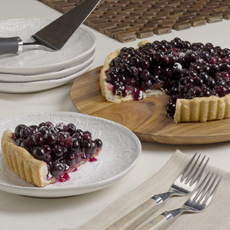|
A few days ago we featured the lattice pie crust, a beautiful top crust for fruit pies (and optionally, to decorate tarts, which typically don’t have top crusts). Some home bakers may be wary, not knowing if they have the patience to evenly cut and weave the strips of dough (fear not—it’s really easy).
But You don’t need much extra time or skill to turn a conventional pie crust into a polka-dot pie, an inspiration of one of our baking heroes, Audra, The Baker Chick.
As beguiling as a homemade pie is when you bring it to the table, this peekaboo pie is even more so (and even more so when there’s a bright-colored fruit peeking through).
How simple is it? When you make your pie recipe, simply use a small cookie cutter to cut polka-dots in the top crust. (You can sprinkle the cut-out circles of dough with cinnamon sugar or grated cheese and bake them.)
Here’s the recipe for Audra’s succulent peach pie. Take the time to peruse The Baker Chick website for many wonderful recipes.
Do you know the difference between a pie and a tart? Many people use the terms interchangeably, but that’s incorrect. Would you call a muffin a cupcake?
There are some similarities, but more differences. Here’s the scoop:
PIES VS. TARTS: THE DIFFERENCE
The terms aren’t interchangeable, even if the products are equally delicious for dessert (or a savory versions—think vegetable tart and chicken pot pie—for lunch or dinner). Here, the differences between pies and tarts. First…
Pies & Tarts: The Similarities
Crust & Filling. Both tarts and pies comprise a pastry crust with a filling that can be sweet or savory.
Multiple Or Individual Servings. Both pies and tarts are multiple serving dishes. While individual-size pies are called mini pies, an individual tart is a tartlet.
Pies & Tarts: The Differences
Number Of Crusts. A pie can have a full top crust, a lattice, or be open-faced (no top crust). A tart has only a bottom crust. Flans and quiches are also tarts; and a cheesecake is a cheese-custard tart.
Type Of Crust. While both pie and tart crusts use the same ingredients (flour, shortening, cold water, salt and sometimes sugar), they are in different proportions for different purposes.
> Pie crusts are thin, soft, flaky pastry that can be made with different types of shortening. Typically, vegetable shortening or lard is used. The pie is served from the pie pan.
> Tart crusts are traditionally made with butter to achieve a buttery pastry flavor. The tart crust is firm such that the tart can stand independently when removed from the tart pan. A tart is meant to be unmolded before serving. While it can be served from the pan, the idea is to enjoy the beauty of the standing tart without the pan. This is especially true with a beautiful fluted crust.
Type Of Pan. The sides of a pie dish or pan are sloped and the dish can be made from a variety of material, such as ceramic, glass or metal. A tart pan is metal with straight or straight fluted side with a removable bottom. A pastry ring atop a baking sheet can also be used.
Size. A standard pie pan is 9 inches in diameter and 1-1/4 inches deep. Other common sizes are 9-1/2 inches and 10 inches. Tart pans range from 10 to 12 inches in diameter, with a depth from 3/4 inches to 2 inches. There are also rectangular tart pans, typically ranging from 11 inches to 15 inches in length, that make a handsome presentation.
Consistency Of Filling. Pie fillings can be loose (fruit pie) or firm (custard pie and pecan pie, for example). Tarts have firm fillings, based on more eggs or other binders. This is especially important since the tart is free-standing—no pie plate for the juices to run into.
Now that you know the difference:
> Take a look at the different types of pies in our beautiful Pie & Pastry Glossary.
> The history of pie.
> The history of pie and pastry.
|
|

[1] Showcase your fruit pie, as in this peach pie with a polka-dot crust. Here’s the recipe (photo © The Baker Chick).

[2] A pie has a thin crust, generally unsweetened. A tart (like this blueberry tart) has a thick crust, typically sweetened and almost cookie-like. The sides stand up straight, without the need of support from a baking dish (photo © Chilean Blueberry Committee | Fruits From Chile).

[3] A tart is always made without a top crust. Pies can also be made with a bottom crust only, as in this open-face blueberry pie. Here’s the recipe (photo © Love And Food For Eva).

[4] A tarts pan has a removable bottom, allowing for the entire tart to be lifted up out of the pan Here’s the recipe for this heirloom tomato and ricotta tart (photo © Tasting Table).
|






